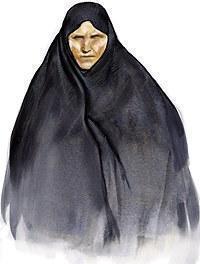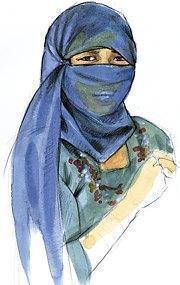Interpreting veils | Story: Meanings have changed with politics, history
 |
 |
The burka comes in many variations, but in its
most conservative form, it thoroughly covers the face
of the person wearing it, leaving only a mesh-like
screen to see through. This refugee is wearing the
conservative burka that the Taliban regime requires
women in Afghanistan to don outdoors. The burka is
thought to have originated in the Arabian peninsula
and can still be found there today. They are not
always as conservative in form as the one shown here
and often allow parts of a woman's face to show
through. |
The word hijab refers to the variety of
styles in which Muslim women use scarves and large
pieces of cloth to cover their hair, neck and
sometimes shoulders. As shown on this Seattle-area
Muslim woman, the hijab often leaves the entire face
open. In the United States, the hijab is the most
common form of headcovering for Muslim women. |
 |
 |
 |
 |
The chador is the full-body cloak Muslim women in
Iran are expected to wear outdoors. Depending on how
it is designed and on how the woman holds it, the
chador may or may not cover the face. The chador was
forbidden in Iran under the reign of Mohammad Reza
Shah, who was brought to power with help from the
United States and sought to modernize the country.
After the shah was exiled during the Islamic
Revolution in 1979, the chador became required wear
for all Iranian women. Many Iranians today subvert
their dress-code by wearing Western-style clothing
beneath the chador. |
Hindu women also wear a veil, a practice that
highlights the fact that veiling is not exclusively
Muslim. Traditional and orthodox Hindu women, such as
this one, will cover their heads and at least partly
obscure their faces in the company of unrelated adult
males. Sometimes veiling is accomplished with a loose
end of the woman's sari, and sometimes it is done with
a scarf-like fabric known as the dupatta. |
 |
 |
 |
 |
Many Pakistani Muslims, such as this one, wear
some form of veil. This woman is wearing the nikab
along with a bandana that reads, "God is
great!" The veil existed before Islam existed,
but it has been embraced and spread by the religion.
Not all Muslim women wear a veil, but among those who
do, styles vary wildly, from simple kerchiefs and
elaborate head scarves to full face-and-body
coverings. |
The nikab is the form of Muslim veiling that comes
closest to what is actually meant by the English word
"veil." English speakers tend to use the
word veil as a catch-all term that covers all types of
Muslim head and body coverings. The nikab, worn
in black by this Moroccan woman, is a veil in the true
sense of the word. It covers everything below the
bridge of the nose and the upper cheeks, and sometimes
also covers the forehead. |
 |
 |
ILLUSTRATIONS
BY PAUL SCHMID / THE SEATTLE TIMES
|